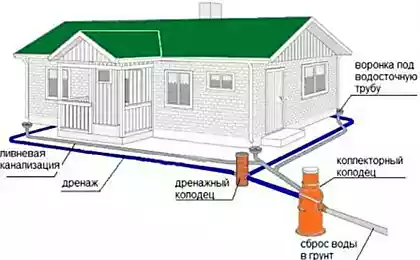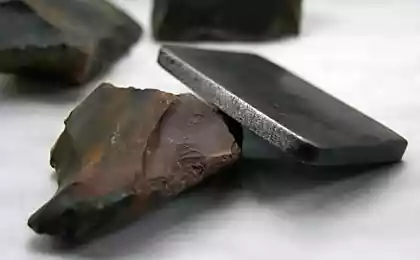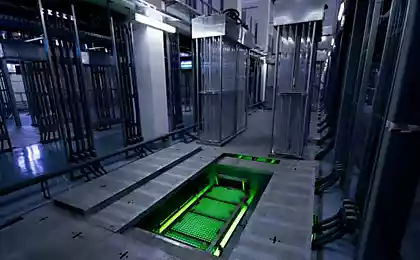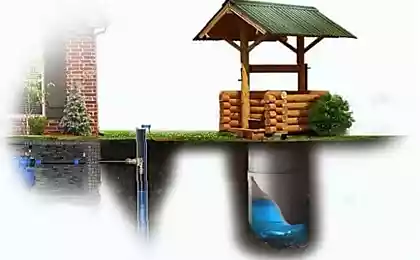544
How to dispose of waste water at the site
Is it possible to clean wastewater and reuse it? Probably not, because of the possibilities of domestic treatment plants is usually not enough for proper water filtration. Much more profitable to use environmentally safe methods of disposal of effluent.
Wastewater – required "Sputnik" any private house, Villa or cottage. Since in such cases it usually is about the country houses, they are usually not connected to a Central sewer system. Therefore, each owner of a private house you have to come up with something original to cope with the waste of life. What method of wastewater disposal is the best?
A septic tank is a deep biological treatmentStart with the most modern variant of the sewage treatment station of deep biological treatment. These "smart containers" suitable for area with any type of soil and groundwater. They provide the highest degree of cleaning, since the tank is the destruction of organic substances by microorganisms.

Bacteria living in the upper layers of silt, actively recycle organic component of sewage
How does it work? Wastewater is collected in a tank where they are pre-biological treatment. After initial purification the liquid goes to the aeration tank (the tank with several compartments, in which there is biochemical wastewater treatment), where she finally gets rid of dirt and turns into sludge. In the sedimentation tank, the composition is infused, and activated sludge gradually pumped into the tank for aerobic stabilization, and part of it can be downloaded manually and used for watering the lawn and non-bearing shrubs and trees.
Bof acteria "work" with the efficiency of 96-98%, completely decomposing the organic component of sewage. Thus purified water is used for irrigation and other household needs. And some men even trying to drink it.
Install a sewage treatment system for a day or two, the bulk of the work is digging a ditch (up to 2 m deep). The station is lowered into the hole, connected to the pipe and buried.
Among the disadvantages of this system usually allocate its energy dependence. For the smooth operation of the compressor, which provides the bacteria with oxygen, require a constant supply of electricity (50-70 watts). Also must not be discharged into the treatment system with chlorine-based detergents, to prevent leakage of oxygen and generally long to leave the station "without work". Upon the occurrence of any of these cases the bacteria will die, and without them the tank will turn into a simple barrel storage of waste.
Cumulative septic tankis the Second most popular method of wastewater disposal is its accumulation and storage and then removal. This method is used even when working with nuclear waste, and even human waste in any case safer.

Cumulative installation – the cheapest and most popular method of wastewater collection
How does it work? A sealed container buried in the ground and periodically cause vacuum trucks for pumping surplus received by the tank mass. Cumulative capacity, in fact, is an improved version of pit latrines. Getting into it, the drains are separated into two fractions: the heavy substances sink to the bottom, while light (such as fat etc.) – rise to the top.
To call scavengers to a yard is expensive and impractical, it makes more sense to cooperate with its neighbors and to rent a car for several yards.
But even excluding this factor, "burying the problem in the ground" has swinecastle. First, the tank can be filled quite quickly, the level of waste water must be constantly monitored and to prevent overfilling. Secondly, the trucks vacuum trucks can not pick up in any plot, and therefore the "accumulation zone" should be located near the roadway.
Cheap septic tank of concrete ringsSimple, effective and ecologically safe solution for owners of sites with a deep groundwater table and sand – set concrete several wells that are isolated from precipitation.
How does it work? In the ground vertically buried two or three concrete well and connects them together tints. In the first well (the bottom of which is hermetically sealed) are the drains of the house, including solid waste. Effluents shimmer or second well (at the bottom of which are deposited fine fraction), or directly into the well for waste disposal. Its bottom is filled with gravel, expanded clay, gravel – the water seeps through and goes into the soil.
In this "concrete septic tank" live and breed anaerobic bacteria, which for the life does not need oxygen. Concrete wells can be of any size (often used COP 10-9) with an internal diameter of 1 m, external – 1.6 m and height 0.9 m. several concrete wells can be "assembled" one buried.

Diagram of concrete septic tanks in section
Among the shortcomings of the "septic" method is called the following:

Multi-chamber installation provides wastewater treatment for subsequent discharge into the ditches
How does it work? In the three-compartment model wastewater first entered the first chamber and the heavy fraction falls to the bottom. After some time they turn into ill. Light particles along with the water enter into the second chamber, where they are processing bacteria. The purified composition is pumped into the third chamber. There it is waiting for the filter and special mesh-antiseptic with bacteria colonies.
Then the purified 60-70% of water is supplied to the filter box, which is a trench with crushed stone, which is laid perforated pipe or infiltrator. Here is post-treatment of sewage by aerobic bacteria, and then the liquid is discharged into the drainage ditch. An integral part of such a sewage treatment system ventilation stack (they are needed for air access and sustain aerobic bacteria).
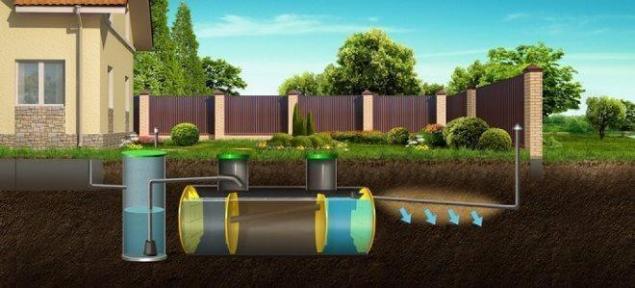
It looks like the septic tank with soil polishing in the form of a multi-camera setup and filtration fields with perforated pipe
What good are the septic tanks? That obtained after the cleaning water can be discharged into the drainage ditch (but use for irrigation and drinking it is not!), for full operation of the system do not need energy sources, and clean the container it is necessary not more frequently than once in 1-3 years.
For a family of 2-3 people is enough to single-chamber septic tank with a production capacity of several cubic meters.
The disadvantages of a septic tank with soil polishing are:
Thus, the wastewater continue to be a serious "headache" owners of private houses. Cleaning methods, after which recycled water is safe to drink, not so much, and they are not cheap. It is easier still to dispose of the sewage in small doses, using modern environmentally friendly technologies. published
P. S. And remember, only by changing their consumption — together we change the world! ©
Join us in Facebook , Vkontakte, Odnoklassniki
Source: www.ogorod.ru/ru/main/tekno/10001/Kak-utilizirivat-stochnye-vody-na-uchastke.htm
Wastewater – required "Sputnik" any private house, Villa or cottage. Since in such cases it usually is about the country houses, they are usually not connected to a Central sewer system. Therefore, each owner of a private house you have to come up with something original to cope with the waste of life. What method of wastewater disposal is the best?
A septic tank is a deep biological treatmentStart with the most modern variant of the sewage treatment station of deep biological treatment. These "smart containers" suitable for area with any type of soil and groundwater. They provide the highest degree of cleaning, since the tank is the destruction of organic substances by microorganisms.

Bacteria living in the upper layers of silt, actively recycle organic component of sewage
How does it work? Wastewater is collected in a tank where they are pre-biological treatment. After initial purification the liquid goes to the aeration tank (the tank with several compartments, in which there is biochemical wastewater treatment), where she finally gets rid of dirt and turns into sludge. In the sedimentation tank, the composition is infused, and activated sludge gradually pumped into the tank for aerobic stabilization, and part of it can be downloaded manually and used for watering the lawn and non-bearing shrubs and trees.
Bof acteria "work" with the efficiency of 96-98%, completely decomposing the organic component of sewage. Thus purified water is used for irrigation and other household needs. And some men even trying to drink it.
Install a sewage treatment system for a day or two, the bulk of the work is digging a ditch (up to 2 m deep). The station is lowered into the hole, connected to the pipe and buried.
Among the disadvantages of this system usually allocate its energy dependence. For the smooth operation of the compressor, which provides the bacteria with oxygen, require a constant supply of electricity (50-70 watts). Also must not be discharged into the treatment system with chlorine-based detergents, to prevent leakage of oxygen and generally long to leave the station "without work". Upon the occurrence of any of these cases the bacteria will die, and without them the tank will turn into a simple barrel storage of waste.
Cumulative septic tankis the Second most popular method of wastewater disposal is its accumulation and storage and then removal. This method is used even when working with nuclear waste, and even human waste in any case safer.

Cumulative installation – the cheapest and most popular method of wastewater collection
How does it work? A sealed container buried in the ground and periodically cause vacuum trucks for pumping surplus received by the tank mass. Cumulative capacity, in fact, is an improved version of pit latrines. Getting into it, the drains are separated into two fractions: the heavy substances sink to the bottom, while light (such as fat etc.) – rise to the top.
To call scavengers to a yard is expensive and impractical, it makes more sense to cooperate with its neighbors and to rent a car for several yards.
But even excluding this factor, "burying the problem in the ground" has swinecastle. First, the tank can be filled quite quickly, the level of waste water must be constantly monitored and to prevent overfilling. Secondly, the trucks vacuum trucks can not pick up in any plot, and therefore the "accumulation zone" should be located near the roadway.
Cheap septic tank of concrete ringsSimple, effective and ecologically safe solution for owners of sites with a deep groundwater table and sand – set concrete several wells that are isolated from precipitation.
How does it work? In the ground vertically buried two or three concrete well and connects them together tints. In the first well (the bottom of which is hermetically sealed) are the drains of the house, including solid waste. Effluents shimmer or second well (at the bottom of which are deposited fine fraction), or directly into the well for waste disposal. Its bottom is filled with gravel, expanded clay, gravel – the water seeps through and goes into the soil.
In this "concrete septic tank" live and breed anaerobic bacteria, which for the life does not need oxygen. Concrete wells can be of any size (often used COP 10-9) with an internal diameter of 1 m, external – 1.6 m and height 0.9 m. several concrete wells can be "assembled" one buried.

Diagram of concrete septic tanks in section
Among the shortcomings of the "septic" method is called the following:
- the water cannot be reused;
- to achieve full containment system of several wells is not yet possible;
- filter the bottom of the wells quickly becomes clogged and ceases to withdraw water into the soil;
- to install such a system would need some serious construction equipment. Will have to do a lot of work, but to call the plumber, as in the case of cumulative installation, it will not protect.

Multi-chamber installation provides wastewater treatment for subsequent discharge into the ditches
How does it work? In the three-compartment model wastewater first entered the first chamber and the heavy fraction falls to the bottom. After some time they turn into ill. Light particles along with the water enter into the second chamber, where they are processing bacteria. The purified composition is pumped into the third chamber. There it is waiting for the filter and special mesh-antiseptic with bacteria colonies.
Then the purified 60-70% of water is supplied to the filter box, which is a trench with crushed stone, which is laid perforated pipe or infiltrator. Here is post-treatment of sewage by aerobic bacteria, and then the liquid is discharged into the drainage ditch. An integral part of such a sewage treatment system ventilation stack (they are needed for air access and sustain aerobic bacteria).

It looks like the septic tank with soil polishing in the form of a multi-camera setup and filtration fields with perforated pipe
What good are the septic tanks? That obtained after the cleaning water can be discharged into the drainage ditch (but use for irrigation and drinking it is not!), for full operation of the system do not need energy sources, and clean the container it is necessary not more frequently than once in 1-3 years.
For a family of 2-3 people is enough to single-chamber septic tank with a production capacity of several cubic meters.
The disadvantages of a septic tank with soil polishing are:
- the inability to use purified water for drinking and irrigation;
- within a radius of 3 m from the filter fields can grow vegetables and plant fruit trees and bushes (for small part it may play a fatal role).
Thus, the wastewater continue to be a serious "headache" owners of private houses. Cleaning methods, after which recycled water is safe to drink, not so much, and they are not cheap. It is easier still to dispose of the sewage in small doses, using modern environmentally friendly technologies. published
P. S. And remember, only by changing their consumption — together we change the world! ©
Join us in Facebook , Vkontakte, Odnoklassniki
Source: www.ogorod.ru/ru/main/tekno/10001/Kak-utilizirivat-stochnye-vody-na-uchastke.htm
Magic time of day – 15 simple rules of our ancestors
The most beautiful views of blooming rhododendrons for Your garden



